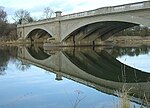Newton, Nottinghamshire
Newton is a hamlet and civil parish in the Rushcliffe district, in the county of Nottinghamshire, England. It is located 1 mile (1.6 km) south-west of East Bridgford and about 1 mile (1.6 km) south-east of the River Trent, close to the junction of the A46 Fosse Way and the A6079. RAF Newton is a disused airfield immediately to the south of Main Street. It opened in July 1940 and closed in 2000. The hangars and other buildings are now used by a number of businesses within the Newton Commercial Centre. Newton Mill was a wooden post mill built before 1855. It ceased work c. 1920 and the buck was dismantled c. 1952. Some parts, including a stone neck bearing, were donated to the Science Museum in London. The brick roundhouse now belongs to the Crown.
Excerpt from the Wikipedia article Newton, Nottinghamshire (License: CC BY-SA 3.0, Authors).Newton, Nottinghamshire
Main Street, Rushcliffe
Geographical coordinates (GPS) Address Nearby Places Show on map
Geographical coordinates (GPS)
| Latitude | Longitude |
|---|---|
| N 52.97 ° | E -0.98 ° |
Address
Main Street
NG13 8HN Rushcliffe
England, United Kingdom
Open on Google Maps








